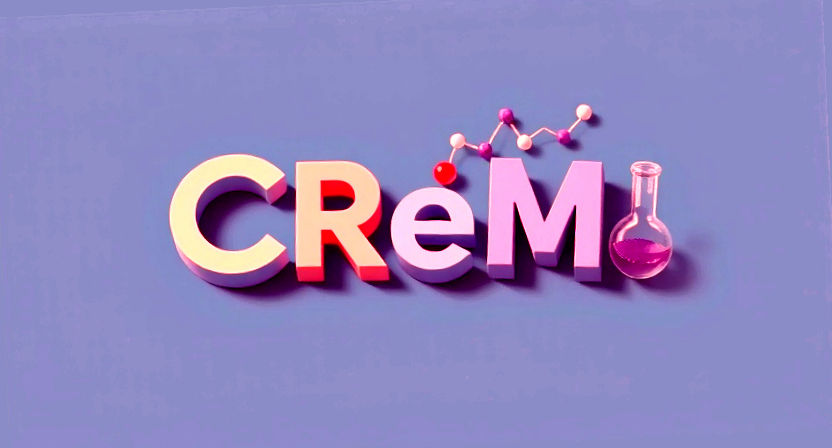CReM Notebook
To access the Jupyter Notebooks associated with this project, please navigate to the examples directory
In addition, apart from the two jupyter notebooks belonging to the original author of CReM, crem_example and crem_ml, all the other notebooks are created by @WyrdWyn4, and would need you to specify the address of the database you are using.
Global Variables and Helper Functions
The database can be downloaded here. I specifically used this database for the notebooks.
1
| db = r"chembl22_sa25_hac12.db"
|
Drawer
Helper functions to draw molecules with highlighting atoms
1
2
3
4
5
6
| from rdkit import Chem
from rdkit.Chem import AllChem
from rdkit.Chem import Draw
from rdkit.Chem.Draw import rdMolDraw2D
from rdkit.Chem.Draw import IPythonConsole
from IPython.display import SVG, Image
|
1
2
3
4
5
6
7
8
9
10
11
12
13
14
15
16
17
18
19
20
21
| def drawsvg(mol, highlightAtoms=[], highlightReplacement=False, molSize=(400, 300), kekulize=True):
mc = Chem.Mol(mol.ToBinary())
if kekulize:
try:
Chem.Kekulize(mc)
except:
mc = Chem.Mol(mol.ToBinary())
if not mc.GetNumConformers():
AllChem.Compute2DCoords(mc)
if highlightReplacement:
ids = []
for a in mol.GetAtoms():
if 'react_atom_idx' not in a.GetPropsAsDict():
ids.append(a.GetIdx())
if ids:
highlightAtoms = ids
drawer = rdMolDraw2D.MolDraw2DSVG(molSize[0], molSize[1])
drawer.DrawMolecule(mc, highlightAtoms=highlightAtoms)
drawer.FinishDrawing()
svg = drawer.GetDrawingText()
return SVG(svg.replace('svg:',''))
|
1
2
3
4
5
6
7
8
9
10
11
12
13
14
15
16
17
18
19
20
21
| def drawgrid(mols, highlight=0):
"""
highlight: 0 - no highlight
1 - highlight changed atoms
2 - highlight unchanged atoms
"""
if highlight == 0:
return Draw.MolsToGridImage(mols[:8], molsPerRow=4, subImgSize=(300,200), useSVG=True)
else:
ids_list = []
for m in mols:
ids = []
for a in m.GetAtoms():
if 'react_atom_idx' not in a.GetPropsAsDict():
ids.append(a.GetIdx())
if highlight == 1:
ids_list.append(ids)
elif highlight == 2:
ids_list.append(list(set(range(m.GetNumAtoms())) - set(ids)))
return Draw.MolsToGridImage(mols, molsPerRow=4, subImgSize=(300,200),
highlightAtomLists=ids_list, useSVG=True)
|
Structure Generation
Mutate Mols
mutate_mol
Generate new molecules by replacing fragments in the supplied molecule with fragments from the database.
1
2
3
4
5
| from crem.crem import mutate_mol
from rdkit import Chem
m = Chem.MolFromSmiles('c1cc(OC)ccc1C')
mols = [Chem.MolFromSmiles(smiles) for smiles in mutate_mol(m, db_name=db, max_size=1)]
|
1
| drawgrid(mols, highlight=1)
|
mutate_mol2:
Convenience function for parallel processing using multiprocessing.
1
2
3
4
5
6
7
8
9
10
| from multiprocessing import Pool
from functools import partial
from crem.crem import mutate_mol2
from rdkit import Chem
p = Pool(2)
input_smi = ['c1ccccc1N', 'NCC(=O)OC', 'NCCCO']
input_mols = [Chem.MolFromSmiles(s) for s in input_smi]
res = list(p.imap(partial(mutate_mol2, db_name=db, max_size=1), input_mols))
|
1
| drawgrid([Chem.MolFromSmiles(s) for s in input_smi] + [Chem.MolFromSmiles(s) for s in res[0]], highlight=1)
|
Grow Mols
grow_mol:
Replace hydrogens with fragments from the database.
1
2
3
4
5
| from crem.crem import grow_mol
from rdkit import Chem
m = Chem.MolFromSmiles('c1cc(OC)ccc1C')
mols = [Chem.MolFromSmiles(smiles) for smiles in grow_mol(m, db_name=db)]
|
1
| drawgrid(mols, highlight=1)
|
grow_mol2:
Convenience function for parallel processing using multiprocessing.
1
2
3
4
5
6
7
8
9
10
| from multiprocessing import Pool
from functools import partial
from crem.crem import grow_mol2
from rdkit import Chem
p = Pool(2)
input_smi = ['c1ccccc1N', 'NCC(=O)OC', 'NCCCO']
input_mols = [Chem.MolFromSmiles(s) for s in input_smi]
res = list(p.imap(partial(grow_mol2, db_name=db), input_mols))
|
1
| drawgrid([Chem.MolFromSmiles(s) for s in input_smi] + [Chem.MolFromSmiles(s) for s in res[0]], highlight=1)
|
Link Mols
link_mols:
Link two molecules by a linker from the database.
1
2
3
4
5
6
| from crem.crem import link_mols
from rdkit import Chem
m1 = Chem.MolFromSmiles('c1cc(OC)ccc1C')
m2 = Chem.MolFromSmiles('NCC(=O)O')
mols = [Chem.MolFromSmiles(smile) for smile in link_mols(m1, m2, db_name=db)]
|
1
| drawgrid(mols, highlight=1)
|
link_mols2:
Convenience function for parallel processing using multiprocessing.
1
2
3
4
5
6
7
8
9
| from multiprocessing import Pool
from functools import partial
from crem.crem import link_mols2
from rdkit import Chem
p = Pool(2)
input_mols = [(Chem.MolFromSmiles('c1cc(OC)ccc1C'), Chem.MolFromSmiles('NCC(=O)O'))]
res = p.starmap(partial(link_mols2, db_name=db), input_mols)
|
1
| drawgrid([Chem.MolFromSmiles('c1cc(OC)ccc1C'), Chem.MolFromSmiles('NCC(=O)O')] + [Chem.MolFromSmiles(s) for s in res[0]], highlight=1)
|
Command Line Utilities
1
2
3
| import os
os.chdir(r'C:\Users\walee\crem\example')
print(os.getcwd())
|
Fragmentation:
Fragment input compounds by cutting bonds matching bond SMARTS.
1
| !python ../crem/fragmentation.py -i ../input-files/input.smi -o ../output-files/output_frag.txt -c 32 -v
|
1
2
3
4
5
6
7
8
9
10
11
12
13
14
15
16
17
| from rdkit import Chem
from rdkit.Chem import Draw
from rdkit.Chem.Draw import rdMolDraw2D
from IPython.display import SVG, display
with open('../output-files/output_frag.txt') as f:
smiles_list = f.readlines()[:8]
## Clean up the SMILES strings and convert to RDKit molecule objects
mols = []
for s in smiles_list:
smiles = s.split(',')[0].strip()
mol = Chem.MolFromSmiles(smiles)
if mol:
mols.append(mol)
drawgrid(mols, highlight=0)
|
Convert Fragments to Environment:
Create text file for fragment replacement from fragmented molecules.
1
| !python -m crem.frag_to_env_mp -i ../input-files/frags.txt -o ../output-files/output_env.txt -r 3 -c 32 -v
|
1
| drawgrid(mols, highlight=0)
|
Create SQLite DB:
Create SQLite DB from a text file containing environment fragments.
1
| !python -m crem.import_env_to_db -i ../input-files/env_frags.txt -o ../output-files/output.db -r 3 -n 32 -v
|
1
| drawgrid(mols, highlight=0)
|
